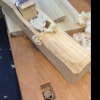
Originally Posted by
Brandon Hanley

Ive been going the sandpaper on glass route and no matter if i only use pull strokes across the paper or push and pull or even right or left handed the edge skews so one side is longer than the other. I use a jig to set the length/angle that was given to me with the guide by another member when i bought a few planes from him.
The main reason for wantung to switch from sandpaper is the mess and mass quanities needed. Ive spent 2 afternoons and about $20 eorth of sandpaper just regrinding this one iron and its still not done just shaped with 80 grit.
As for freehand, only in my wildest dreams. Ive tried for years with knives and finally gave in and learned to use cheaper pocket knives and replace often. I tried with a cheap chisel recently and that ended as i expected.




 Reply With Quote
Reply With Quote


